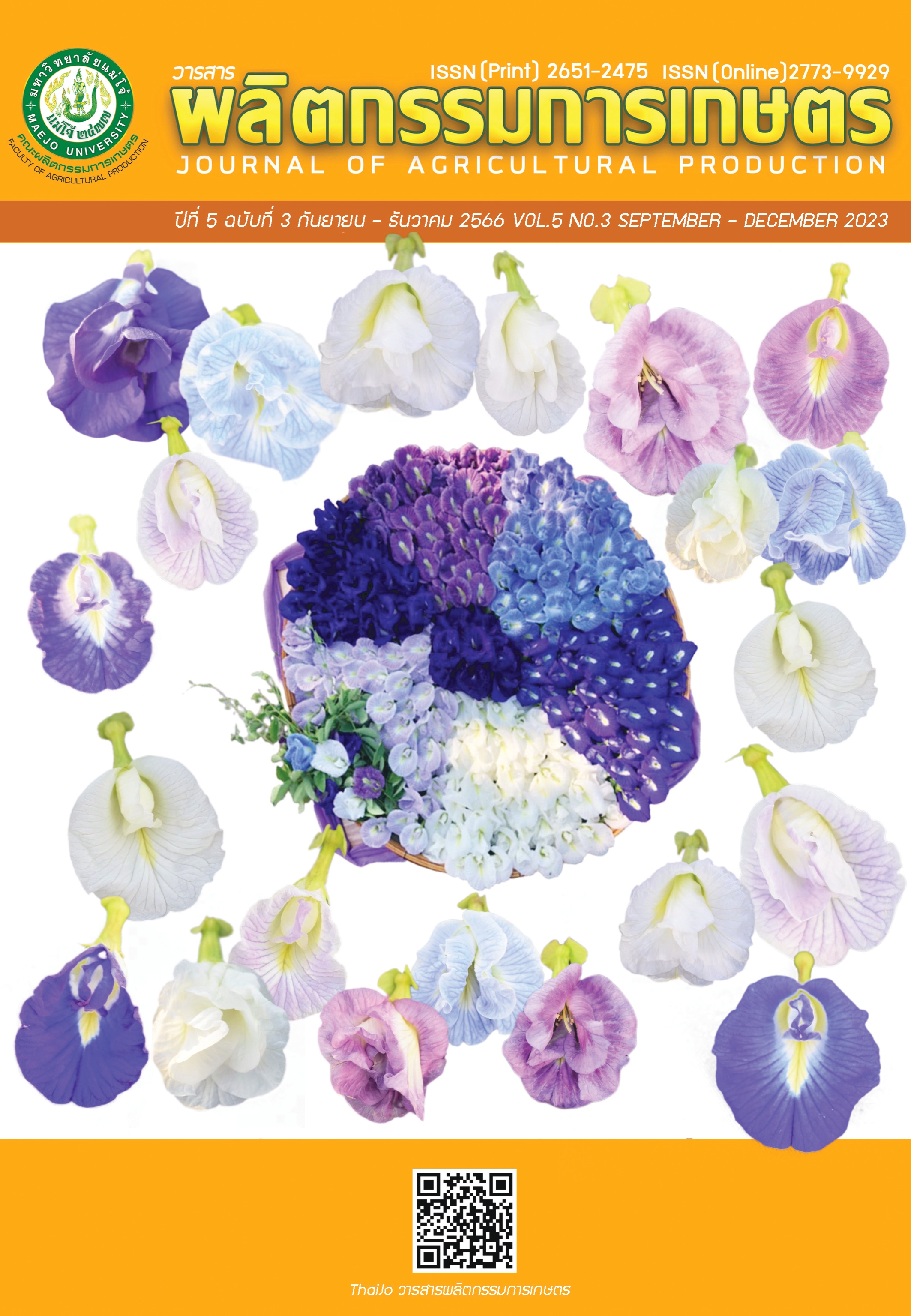ความสัมพันธ์ระหว่างความหนาและความแน่นเนื้อของเปลือกผลนอกต่อองค์ประกอบน้ำมันของทะลายปาล์มน้ำมัน ความสัมพันธ์ระหว่างความหนาและความแน่นเนื้อของเปลือกผลนอกต่อองค์ประกอบน้ำมันของทะลายปาล์มน้ำมัน
Main Article Content
บทคัดย่อ
การเก็บเกี่ยวทะลายปาล์มในระยะสุกแก่ที่เหมาะสมจะช่วยเพิ่มคุณภาพและปริมาณน้ำมันปาล์ม และยังเป็นประโยชน์ในอุตสาหกรรมน้ำมันปาล์ม ดังนั้นวัตถุประสงค์ของการวิจัยนี้ เพื่อศึกษาหาความสัมพันธ์ระหว่างความหนาเนื้อและความแน่นเนื้อของเปลือกนอกต่อองค์ประกอบทะลายที่ระดับความสุกแตกต่างกัน ทะลายปาล์มน้ำมันถูกเก็บเกี่ยวและแบ่งกลุ่มโดยใช้เกณฑ์จำนวนผลร่วงจากทะลายออกเป็น 3 ระยะ ดังนี้ 1-10 11-30 และ 30-40 ผล ตามลำดับโดยผลส่วนล่างและบนของช่อผลถูกเก็บมาจากส่วนโคน กลาง ปลายของทะลายปาล์มน้ำมันทุกทะลาย ผลของทะลายปาล์มน้ำมันถูกนำมาวิเคราะห์ความหนาเนื้อของเปลือกนอก ความแน่นเนื้อ เปอร์เซ็นต์น้ำมันต่อผล และเปอร์เซ็นต์น้ำมันต่อทะลาย ผลการทดลองแสดงว่า ความแน่นเนื้อของทะลายที่มีผลร่วง 30-40 ผล พบว่ามีความสัมพันธ์กับผลส่วนปลายทะลาย (ช่อบน) มีค่าเท่ากับ 49.43 นิวตัน ความสัมพันธ์ระหว่างเปอร์เซ็นต์น้ำมันต่อทะลายและความหนาเนื้อของผลในส่วนกลางทะลาย (ช่อบน) มีค่า r เท่ากับ 0.57 โดยมีค่าความหนาเนื้อเฉลี่ย 0.8 เซนติเมตร นอกจากนี้เปอร์เซ็นต์น้ำมันต่อผลมีความสัมพันธ์กับความหนาของเปลือกนอกของผลในส่วนต่าง ๆ ของทะลาย ซึ่งความหนาเนื้อมีผลต่อเปอร์เซ็นต์น้ำมันต่อผลสูง ระยะความสุกของทะลายปาล์มน้ำมันพบว่ามีผลต่อเปอร์เซ็นต์น้ำมันต่อทะลาย
Article Details

อนุญาตภายใต้เงื่อนไข Creative Commons Attribution-NonCommercial-NoDerivatives 4.0 International License.
เอกสารอ้างอิง
Abdullah, M.Z., L.C. Guan and B.M.N. MohdAzemi. 2001. Stepwise discriminant analysis for colour grading of oil palm using machine vision system. Food and Bioproducts Processing 79(4): 223-231.
Abdullah, M.Z., L.C. Guan, A.M.D. Mohamed and M.A.M. Noor. 2002. Color vision system for ripeness inspection of oil palm Elaeis guineensis. Journal of Food Processing and Preservation 26(3): 213-235.
Azis, A.A. 1990. A simple floatation technique to gauge ripeness of oil palm fruits and their maximum oil content. In: Proceeding of the International Palm Oil Development Conference (PORIM ’90), Kuala Lumpur, Malaysia.
Chucheep, T., N. Mahathaninwong, S. Limhengha,D. Petchui, and P. Templong. 2019. Ripeness Inspection of Oil Palm Fruits by Applying Hardness Test Technique. In Proceedings of the 16th ASEAN Food Conference. 279-283.
Hartley C.W.S. 1988. The Oil Palm. 2nd Longman Publishers Ltd., London.
Keshvadi, A., J.B. Endan, H. Haniff, D. Ahmad and F. Saleena. 2011. The Relationship Between Palm Oil Index Development and Mechanical Properties in the Ripening Process of Tenera Variety Fresh Fruit Bunches. Res. Journal of Applied Science and Emerging Technology 3(3): 218-226.
Hazir, M.H.M., A.R.M. Shariff and M.D. Amiruddin. 2012. Determination of oil palm fresh fruit bunch ripeness based on favonoids and anthocyanin content. Industrial Crops and Products 36(1): 466-475.
Ngalle H.B., J. M. Bell, G.F.N. Ebongue, L. Nyobe, F.C. Ngangnou and G.N. Ntsomboh. 2013. Morphogenesis of Oil Palm Fruit (Elaeis guineensis Jacq.) in Mesocarp and Endocarp Development. Journal of Life Sciences 7(2): 153-158.
Ooi S.C. 1978. Variability in the Deli dura breeding population of the oil palm (Elaeis guineensis Jacq.). IV. Growth and physiological parameters. Malaysian Journal of Sustainable Agriculture 51: 359-365.
Sunilkumar, K. and D.S. SparjanBabu. 2013. Surface color based prediction of oil content in oil palm (Elaeis guineensis Jacq.) fresh fruit bunch. Afr. Thai Journal of Agricultural Science Research 8(6): 564-569.
Thomas, R.L., P. Sew, C.K. Mok, K.W. Chan, P.T. Easau and S.C. NG. 1971. Fruit Ripening in the Oil-palm Elaeis guineensis. Annals of Botany 35: 1219-1225.


